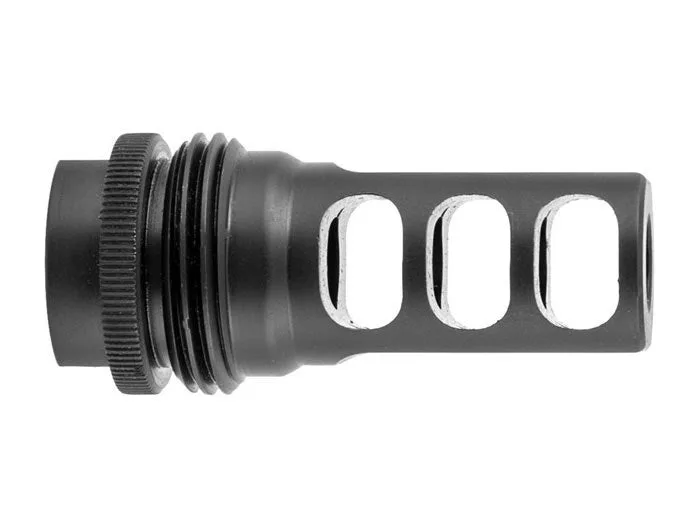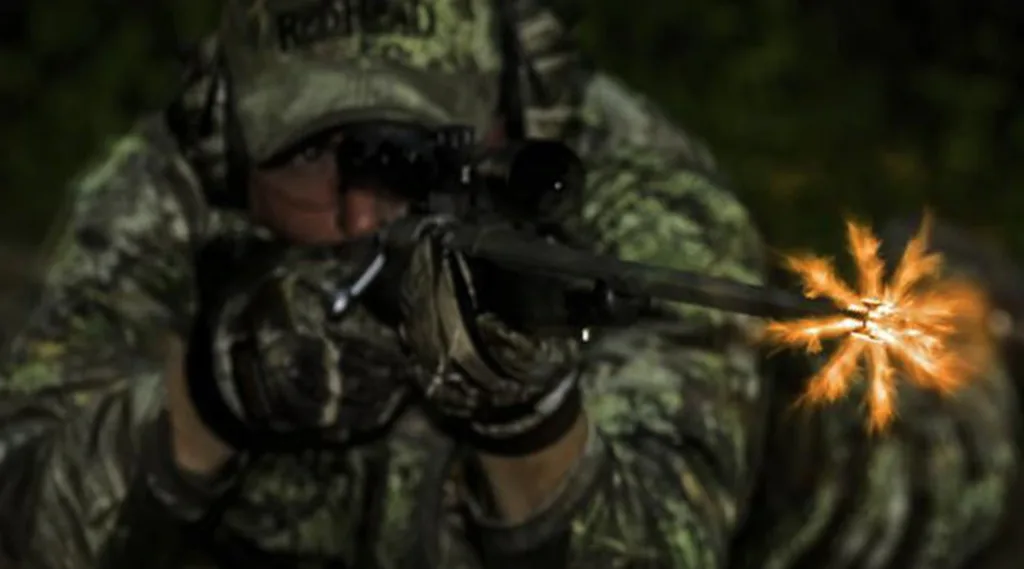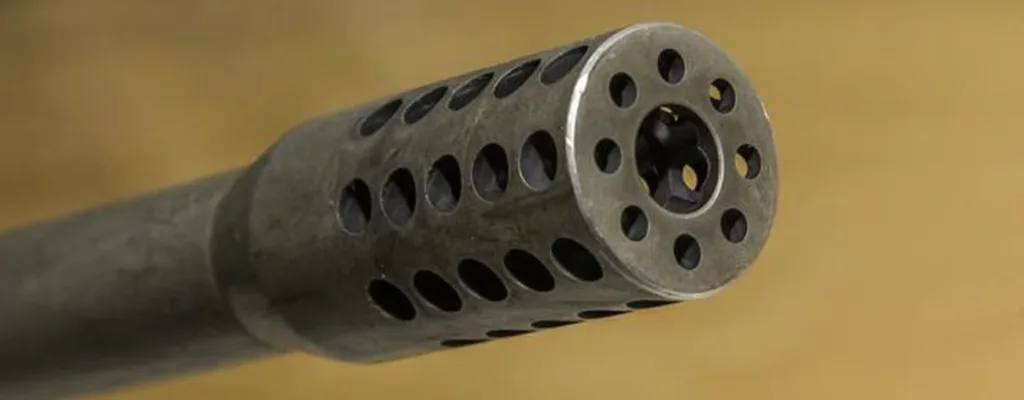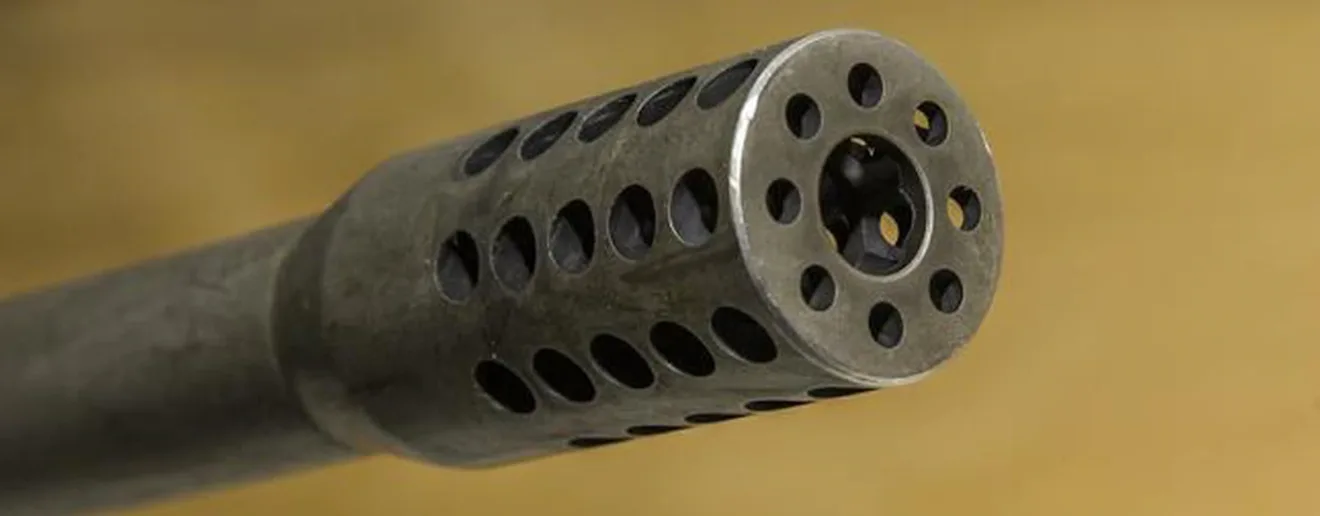_We may earn revenue from the products available on this page and participate in affiliate programs. Learn more ›
_

Silencerco Harvester Big Bore Muzzle Brake. Brownell’s
This whole question of whether to put a muzzle brake on your rifle comes up because I’m contemplating removing the flash suppressor from my Ruger Scout Rifle
(hereinafter referred to as GSR, for Gunsite Scout Rifle, which is what Ruger calls it). The primary function of a flash suppressor is to keep the shooter from being blinded by the muzzle flash of a short-barreled carbine. The secondary role is to keep the muzzle flash from being seen by people who may not have your best interests in mind.
Flash suppressors are not new. The very horrible Enfield No. 5 Mk 1 Jungle Carbine, which was issued in World War II, had a cone-shaped suppressor. M-14s have suppressors, even though they have rifle-length barrels. And, of course, every rifle we issue, from the M-16 on forward, has one. They work by rapidly cooling the gas that exits a rifle’s muzzle.
I have mixed feelings about my GSR’s suppressor. I don’t know if the rifle really needs it, and aside from managing gas balls, it gets in the way. Richard Mann, who literally wrote the book on Scout rifles
, detests all muzzle brakes and flash suppressors, and I put much weight in his opinion.
Will removing it change the rifle’s point of impact or its accuracy?
Will I be blinded by gas? (I have been blinded by gas balls due to tent farts, not muzzle flash. I recovered, however.)
I will have to find out. In the meanwhile, here are some thoughts on muzzle brakes, which are becoming more and more popular.
What Does a Muzzle Brake Do?
A muzzle brake is a simple device added to the end of a rifle barrel that reduces felt recoil. It’s basic science: Powder gas travels straight down the barrel, directly away from the shooter. The force created by the gas to propel the bullet forward creates an equal amount of rearward force, which sends the rifle into your quivering shoulder and your throbbing head. Muzzle brakes redirect the gas, sort of like lifting one buttock while sitting on a hard chair in school assembly. If you send the gas upward, muzzle jump is reduced. If you send it to the side, rearward recoil is reduced.
A muzzle brake is nothing more than a steel tube, slightly larger in diameter than the barrel. It either screws onto the muzzle or is a permanent part of the barrel. In the tube are rows of small holes that let the gas pass. Sometimes brakes are made in the shape of a clamshell with slots instead of holes. These are most commonly seen on rifles chambered for the .50 BMG.

By redirecting gasses outward, a muzzle brake reduces felt recoil. Field & Stream Online Editors
Do Muzzle Brakes Work?
Oh my goodness, yes. A couple of years ago, my gunsmith friend John Blauvelt and I did some shooting with a Kenny Jarrett .300 Win. Mag. equipped with one of Kenny’s muzzle brakes. There was so little recoil that we found the experience unsettling. It was like shooting a .22/250. I’ve shot rifles chambered for the .50 BMG that would probably snap your collarbone without a muzzle brake. With one, they kicked hardly at all, though smoke poured backward and went up my nose.
Muzzle brakes seem to make rifles more accurate, as well. Part of this is the reduction in recoil, which reduces shooter tremor brought on by terror, and (possibly) because vibration in the barrel is reduced. Prairie-dog hunters frequently put a muzzle brake on their heavy-barreled .22 centerfires to make the guns virtually recoilless. This enables them to see bullet splashes and, if conditions are right, to actually follow the path of the bullet to the target.
The Downsides of Using a Muzzle Brake
Before you rush out to have a muzzle brake installed on your rifle (for about $300; get a good gunsmith to do the job), be aware of a few drawbacks.
• They Change How Your Rifle Handles
First, they make your barrel longer by about 3 inches, which can transform a handy rifle into a cumbersome gun. If you have the barrel shortened to compensate for the added length, you’ll lose velocity.
• They Change How Your Rifle Shoots
This can be an upside or a downside. But no matter what, it’s a risk. As mentioned above, there’s a decent chance that adding a muzzle brake will improve your gun’s accuracy. On other hand, it may not. Worst case: Your previously accurate rifle may no longer shoot so well with a muzzle brake added. There’s no way to know for sure.
• They Will Deafen You (If You’re Not Careful)
The biggest problem is noise. A muzzle brake will deafen you if you are not very careful. With the muzzle blast coming toward you instead of traveling away from you, the report goes from unpleasant and ear-damaging to unbearable and ear-killing. You can’t shoot a muzzle-braked rifle without earmuffs, period, even when you’re hunting.
• They Require Extra Maintenance
This is a very minor inconvenience, but when you clean a braked rifle, you should remove the brake or you’ll get all sorts of nasty stuff in the little holes. You should also clean the brake; get the carbon out of the holes with a pipe cleaner dipped in powder solvent, and be sure that the threads on the barrel are kept greased (choke-tube lube is ideal) or dirty powder gas will eventually seep into them and render your brake unscrewable.
Should You Get a Muzzle Brake for Your Rifle?

Carefully consider the pros and cons before deciding to get a muzzle brake. Field & Stream Online Editors
Well, first off, some rifles absolutely require a muzzle brake, including the .378, .416, and .460 Weatherby, any of the mega-.30s, like the .30/378, or the .338 Lapua, and similar nightmares.
Muzzle brakes are indispensable for shooters who are working alone, or at long range, and must keep their sight picture during recoil to see the bullet strike. Just about all sniper rifles, even the 15-pound .308s that have hardly any recoil, now come with muzzle brakes.
Dangerous-game rifles should not have muzzle brakes. They’ll deafen your trackers, who will be alongside you, and you don’t want your trackers unable to hear something coming that is about to stomp you into hairy strawberry ice cream.
There is also the question of manliness. Among the many things that I can’t adjust to is the redefinition of Manly Behavior. (I am told that Bill Heavey is exploring this very subject here
. Read it for entertainment if you will, but trust me, if Bill had wandered into elk camp 50 years ago, he would have been beaten to death on general principle.) In the 1950s, when my brain hardened into its present shape, men did not wear earrings, cry, or help with the housework. Or use muzzle brakes. But that is all gone now, and while I can’t explain any of the other stuff, I can at least tell you why lots of more or less manly shooters are saying no to recoil: because they shoot better without it.
Muzzle brakes are a blessing, albeit a mixed one. I like them, but only in rarified conditions. You will have to decide for yourself


